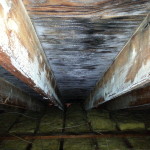We have stated that there are no accepted numerical standards for mold concentrations. Several previous attempts at suggesting numerical concentrations have failed due to the enormous diversity of the thousands of mold species that naturally occur, and to the wide variability in human responses to these species. Most professional doubt that we will ever have a set of exposure limits like we have for other indoor contaminants such as radon, asbestos and lead.
This does not mean, however, that there are no standards with which to conduct a competent assessment or remediation project. Numerous public and private agencies in the US have written standards for biological contaminants, starting with the Environmental Protection Agency (EPA) and the American Conference of Governmental Industrial Hygienists (ACGIH) in the late 1980’s. The body of professional standards has grown steadily since. A sampling of the evolution of professional industry standards is shown below.
- Environmental Protection Agency (EPA) Guide for Building Owners and Facility Managers 1991.
- Environmental Protection Agency (EPA) Indoor Air Quality Tools for Schools 1995.
- Environmental Protection Agency (EPA) Mold Remediation in schools and Commercial Buildings (2001)
- American Conference of Governmental Industrial Hygienists (ACGIH) Guidelines for the Assessment of Bioaerosols in the Indoor Environment, 1989
- American Conference of Governmental Industrial Hygienists (ACGIH) Bioaerosols: Assessment and Control 1999.
- National Institute of Occupational Safety and Health (NIOSH) Guidance for Indoor Air Quality Investigations 1992.
- American Industrial Hygiene Association (AIHA) Field Guide for the Determination of Biological Contaminants in Environmental Samples 1996.
- American Industrial Hygiene Association (AIHA) Assessment, Remediation, and Post Remediation Verification of Mold in Buildings (2004)
- New York City Department of Health (NYCDOH) Guidelines on Assessment and Remediation of Fungi in Indoor Environments, 1993 (revised several times)
- Institute of Inspection, Cleaning and Restoration Certification (IICRC) Standard and Reference Guide for Professional Water Damage Restoration, 1994 (revised 1999)
As described and supported by the above publications, the amplification of biological populations should not be tolerated in occupied buildings. The presence of amplification requires mitigation measures to remove the biological growth.
Existing industry standards indicate the need to remove affected porous materials, clean affected non-porous materials, and thoroughly clean all surfaces in the area of the contamination. The need to control and prevent excess moisture is paramount in preventing further mold activity.
Caution is advised in the use of disinfectants, to ensure that building occupants are not exposed to chemical biocides that can be hazardous with uncontrolled use.
AIR Consulting Services recommends a common sense approach to mold assessment. The approach of identifying potential sources of water damage and mold contamination, rather than of testing the indoor environment for multiple contaminants, has become the industry standard.
